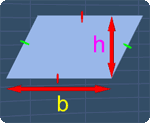
Area of a Parallelogram
Lesson Objective
In this lesson, we will learn about the area of
a parallelogram.
About This Lesson
In this lesson, we will:
- Learn about the formula for the area of a parallelogram
- See an example on using the formula to calculate a parallelogram's area
- See another example on using the formula to calculate the height of a parallelogram

Tip #1
A parallelogram has two pairs of parallel sides and its opposite sides are equal
in length. These properties are shown on the right.
Now, if the parallelogram has the base b and the height h, the area, A, of the parallelogram will be:


The math video below will give more explanations on this. Also, we will see some examples on how to use this formula.
Now, if the parallelogram has the base b and the height h, the area, A, of the parallelogram will be:
A = bh


The math video below will give more explanations on this. Also, we will see some examples on how to use this formula.
Math Video Transcript
Multiple Choice Questions (MCQ)
Now, let's try some MCQ questions to understand
this lesson better.
You can start by going through the series of questions on the area of a parallelogram or pick your choice of question below.
You can start by going through the series of questions on the area of a parallelogram or pick your choice of question below.
- Question 1 on finding the area of a parallelogram
- Question 2 on finding the height of a parallelogram